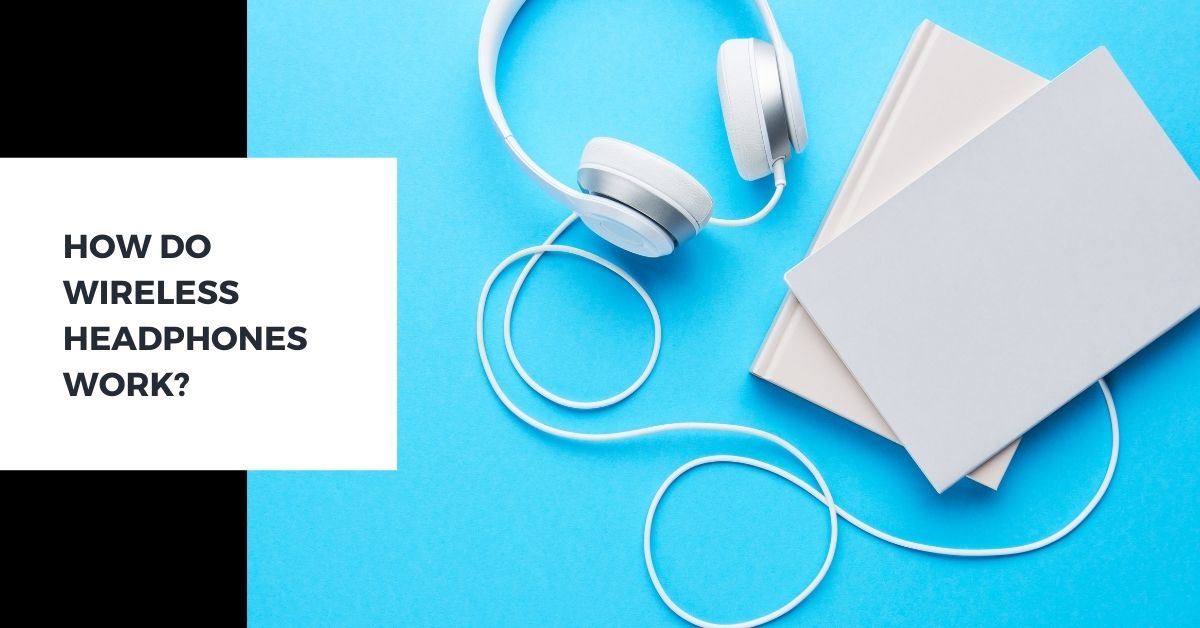We can’t imagine our lives without wireless headphones. As wireless headphones have made our daily activities so convenient, it will be important to know how these remarkable devices work. So this is where we address how do wireless headphones work.
There was a great technological advancement from wired headphones to wireless headphones. This is all happening due to the Bluetooth technology with which the brands have successfully integrated these devices with. Usually, conventional wireless headphones connect to output in three ways. These are infrared waves, radio waves, and Bluetooth signals. These are some of the majorly utilized mediums for the functioning of wireless headphones.
Out of the three, Bluetooth is the preferred choice for connectivity (the topic will be covered later). Through these wavelengths, the headphones connect with any Bluetooth-compatible device. This can be your television, mobile phone, and laptop. The headphone needs only Bluetooth signal to connect with the source devices.
Many consumers started to appreciate the benefits of using wireless headphones. But there are other consumers who are still wondering how these techniques work and sometimes how to use wireless headphones. We completely agree that it’s not the mistake of the consumers. Because the brands use complicated terms that confuse the buyers.
How do wireless headphones work?
Wireless headphones are known by many names. They are often closely related to Bluetooth headphones. These headphones are solely dependent on the Bluetooth signals for successfully transmitting audio between the platforms. There are two major components that are involved in the functioning of wireless headphones. The first is the transmitter and the second is the receiver. Through this, you can see the working process of the transmitter and receiver in wireless headphones.
Transmission process
The transmission process is always the device that is used to stream the media files. It can be audio or video files that are dependent on the usage of consumers. Some of the transmission devices can be televisions, Bluetooth speakers, mobile phones, and laptops.
You can find the transmitters in the form of a small chip which will be located within these devices. And these chips help in generating the transmission frequency towards your wireless headphones. The transmission signal is passed through the air by using the radio frequency.
Receiving process
The receiving device is your wireless headphones. As it is powered by Bluetooth technology, it specializes in capturing radio frequencies. The radio frequencies have been configured to receive signals of a certain wavelength. And the wireless headphone starts to function with the power of the integrated battery.
Wireless headphones actively work in converting these signals into the audio of sound that you wish to listen to. For this process to successfully happen, both the devices need to be paired with each other. However, the transmission and receiving quality is purely based on the Bluetooth technology that the devices have been built for.
Suggested read: Why do my wired headphones keep cutting out?
What is the difference between infrared, radio signals and Bluetooth connections?
All three transmission signals have a core objective to connect the transmitter and receiver. It completely depends on the type of headphones that you have bought for yourself. If you look at the functionality part, it is almost similar to each other.
The infrared-enabled wireless headphones are popularly known for transmitting the best sound quality for wireless devices. As they work with high-frequency signals, this is one of the most beneficial factors for transmission quality. The downside of infrared wireless headphones is that they require huge power to run the device.
Radio signals enable wireless headphones to help to give more range. As you all know, when you use a radio box in your home, it tends to capture signals from a long distance. This is the power that radio signals that enable wireless headphones to receive signals from a greater distance.
The Bluetooth technology-enabled wireless headphones are one of the most popularly found in the market. Because of its usability and functionality, Bluetooth technology is one of the most popular ways of connecting wireless headphones with the audio source. The only downside of using Bluetooth technology is its range. However, it can cover only up to 30 feet. And if we look at the positive side, it is the only technology where you can connect the device based on identity verification.
How to connect wireless headphones with the audio source?
Nowadays you find Bluetooth enabled in almost every device. Starting from the televisions till the air conditioner that you have installed in your home. All the home appliances are being introduced with Bluetooth technology so that the connectivity factor is more convenient.
The connectivity is purely based on the type of audio source you wish to get associated with. If you are using a mobile phone, laptop, desktop for Bluetooth enabled speakers, the connectivity process differs. But to give a general overview, you need to enable the Bluetooth connection from the device and the source of the device. Later you need to pair it with the respective code given by the brand. After successful configuration, the wireless headphone starts to function.
You can learn more about it here: How to use wireless headphones?
What is the range of wireless headphones?
The range is completely dependent on the brand of wireless headphones that you have purchased. Usually, you can get a wireless headphone in the market that ranges from 10 to 40 feet.
If there is any obstacle between them like the wall of your home, it tends to disrupt the transmission signal. However, the Bluetooth signals are not strong compared to the radio waves. It needs to have a clear space for better audio transmission quality.
How long does the battery last for wireless headphones?
The battery of the wireless headphone is one of the most distinguishing factors that influence the purchasing behaviour of the consumers. By addressing this issue, the brands are striving hard to introduce better wireless headphones which come with a higher range.
Currently, in the market, you can find wireless headphones ranging from 24 to 48 hours of battery backup. If you are considering the standby time, it goes up to 30 days. The battery range relies on the way you use the headphones. For example, if you are tuning into songs in high volume or if you are maintaining a long distance from the audio source. These are some of the factors that influence the battery lifespan.
Suggested read: What are noise cancelling headphones?
Conclusion
As we are moving from wired devices to wireless technology is truly exceptional. One of the important factors that Bluetooth technology is getting popular for headphones or any wireless device is because of its security. Unlike radio devices that can easily connect with any platform. It’s not the same with Bluetooth technology, as the signal has to be verified. Post verification using codes, the devices can get integrated.
If you look at the working process of these devices, it isn’t as complicated as we assumed. However, with the help of two major functions that are transmitter and receiver, the functioning of wireless headphones takes place. I hope that you are now aware of how do wireless headphones work. If you are facing any issues in using the wireless headphones, you can check why are my headphones not working.
Feel free to drop down your thoughts in the comment section below.

